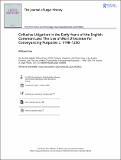Files in this item
Collusive litigation in the early years of the English common law : the Use of Mort d'Ancestor for conveyancing purposes c. 1198-1230
Item metadata
| dc.contributor.author | Eves, William | |
| dc.date.accessioned | 2020-11-20T13:30:01Z | |
| dc.date.available | 2020-11-20T13:30:01Z | |
| dc.date.issued | 2020-11-19 | |
| dc.identifier | 270792763 | |
| dc.identifier | cf19e6f7-0c9c-4eb2-8a1b-9c35c0c7ddb8 | |
| dc.identifier | 85096329566 | |
| dc.identifier | 000592252800001 | |
| dc.identifier.citation | Eves , W 2020 , ' Collusive litigation in the early years of the English common law : the Use of Mort d'Ancestor for conveyancing purposes c. 1198-1230 ' , Journal of Legal History , vol. Latest Articles . https://doi.org/10.1080/01440365.2020.1839692 | en |
| dc.identifier.issn | 0144-0365 | |
| dc.identifier.uri | https://hdl.handle.net/10023/21024 | |
| dc.description | This project has received funding from the European Research Council (ERC) under the European Union’s Horizon 2020 research and innovation programme (grant agreement No. 740611). | en |
| dc.description.abstract | The extent to which real actions such as mort d’ancestor were used collusively for conveyancing purposes in the early years of the English common law is subject to debate. This article first discusses why parties to a transfer of land might engage in collusive litigation, before surveying the existing literature on the question of how collusive suits can be identified, and the suggestions which have been made as to the prevalence of collusive litigation in the late-twelfth and early-thirteenth centuries. It then discusses a method which may be used to provide a more precise answer to this question, and employs this method to uncover the extent to which mort d’ancestor could have been used collusively in the period c.1198–1230. It concludes with a suggestion that this method could be used in relation to other early common law actions to further our understanding of litigation and conveyancing in the period. | |
| dc.format.extent | 31 | |
| dc.format.extent | 2399483 | |
| dc.language.iso | eng | |
| dc.relation.ispartof | Journal of Legal History | en |
| dc.subject | Mort d'ancestor | en |
| dc.subject | Conveyancing | en |
| dc.subject | Collusive litigation | en |
| dc.subject | Fines | en |
| dc.subject | Final concords | en |
| dc.subject | Common law | en |
| dc.subject | DA Great Britain | en |
| dc.subject | KD England and Wales | en |
| dc.subject | T-NDAS | en |
| dc.subject.lcc | DA | en |
| dc.subject.lcc | KD | en |
| dc.title | Collusive litigation in the early years of the English common law : the Use of Mort d'Ancestor for conveyancing purposes c. 1198-1230 | en |
| dc.type | Journal article | en |
| dc.contributor.sponsor | European Research Council | en |
| dc.contributor.institution | University of St Andrews. School of History | en |
| dc.contributor.institution | University of St Andrews. Institute of Legal and Constitutional Research | en |
| dc.identifier.doi | https://doi.org/10.1080/01440365.2020.1839692 | |
| dc.description.status | Peer reviewed | en |
| dc.identifier.grantnumber | 740611 | en |
This item appears in the following Collection(s)
Items in the St Andrews Research Repository are protected by copyright, with all rights reserved, unless otherwise indicated.

